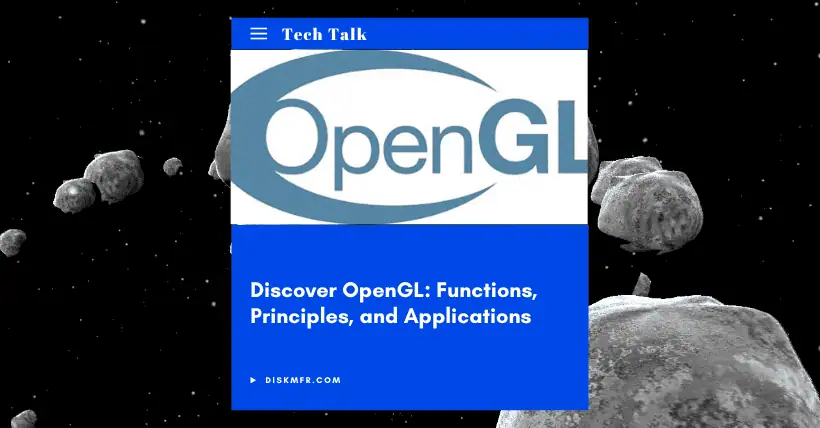I. Introduction
OpenGL, short for “Open Graphics Library,” is a cross-language, cross-platform application programming interface (API) used for rendering 2D and 3D graphics. In simple terms, it serves a similar purpose as DirectX 3D and Vulkan, providing a way to render graphics across different platforms and languages.
II. History of OpenGL
OpenGL originated in the early 1990s when Silicon Graphics Inc. (SGI) developed a graphics library called IRIS GL for their graphics workstations, gaining attention in the professional graphics field. Later, SGI developed OpenGL based on IRIS GL and released it as an open, cross-platform graphics API.
In 1992, OpenGL 1.0 was officially released, providing developers with a series of basic graphic rendering functions, such as drawing points, lines, triangles, and other basic graphical primitives. The release of this version marked the beginning of OpenGL’s global presence, capturing the attention of developers.
OpenGL 1.1 was released in 1995, adding support for new features like texture mapping and fog effects, greatly enhancing the visual effects of graphic rendering. In 2004, OpenGL 2.0 was introduced, introducing the concept of programmable pipelines, allowing developers to write vertex and fragment shaders to customize the graphic rendering process.
Over time, OpenGL has continued to evolve, adding new features and functionalities, and the current OpenGL version has reached the OpenGL 4.x series, achieving new heights in performance and functionality.
III. Features of OpenGL
✅ Rich Graphic Rendering Capabilities
OpenGL offers a wide range of graphic rendering functions, capable of drawing various basic graphic primitives like points, lines, triangles, and quadrilaterals. By combining and transforming these basic primitives, developers can build complex 3D models.
✅ Powerful Transformation Capabilities
In graphic rendering, objects often need to undergo transformations such as translation, rotation, and scaling. OpenGL provides built-in transformation matrix functions, allowing developers to easily implement various transformations on graphics.
✅ Texture Mapping Technology
Texture mapping is a key feature of OpenGL that allows developers to map 2D images (textures) onto the surfaces of 3D objects, adding detail and realism to the objects.
For example, when creating a 3D model of a wooden table, a wood grain texture image can be mapped onto the table’s surface to make it appear as if it is truly made of wood.
OpenGL supports various texture formats and mapping methods, and developers can choose the appropriate settings to achieve the best visual effect.
✅ Lighting and Material Simulation
To make 3D scenes more realistic, OpenGL provides lighting and material simulation features. Developers can define different types of light sources, such as point lights, spotlights, and directional lights, and set properties like the color, intensity, and position of the light sources.
Simultaneously, material properties such as diffuse coefficient, specular coefficient, and glossiness can be defined for objects to simulate how different materials reflect and refract light.
For example, metal and plastic materials behave differently under the same lighting conditions, and OpenGL can accurately simulate this difference, making objects in the scene appear more realistic.
IV. Applications of OpenGL
✅ Game Development
Games are one of the most common areas where OpenGL is used. In modern 3D games, OpenGL is employed to create realistic game environments, character models, and effects.
For example, many major AAA games, such as the “Assassin’s Creed” series and the “Tomb Raider” series, heavily rely on OpenGL to achieve high-quality graphic rendering, providing players with an immersive gaming experience. OpenGL’s high performance and flexibility allow game developers to fully unleash their creativity and create stunning game visuals.
✅ Computer-Aided Design (CAD) and Industrial Simulation
In the fields of CAD and industrial simulation, OpenGL is widely used to create and display complex 3D models. Engineers can use OpenGL-based software to design mechanical parts, architectural structures, and more, and visually inspect the models’ appearance and performance through real-time rendering.
In industrial simulations, such as car crash simulations or airplane flight simulations, OpenGL is used to visually present the results, assisting engineers in analyzing and optimizing designs. OpenGL’s high-precision rendering and ability to handle complex models make it indispensable in these professional fields.
✅ Film and Visual Effects Production
OpenGL also plays a role in film and visual effects production. Although the film industry typically uses specialized effects software, these programs often rely on OpenGL technology for their underlying graphic rendering.
For example, OpenGL can be used in virtual scene creation and character animation in some movies, helping achieve efficient graphic rendering and real-time previews, improving the efficiency and quality of visual effects production.
V. Conclusion
In conclusion, OpenGL is a powerful graphic rendering API. With its rich feature set, efficient operation, and wide range of applications, it has made significant contributions to the field of computer graphics and remains highly popular. As computer technology continues to advance, OpenGL will continue to evolve in the future.

Disclaimer:
- This channel does not make any representations or warranties regarding the availability, accuracy, timeliness, effectiveness, or completeness of any information posted. It hereby disclaims any liability or consequences arising from the use of the information.
- This channel is non-commercial and non-profit. The re-posted content does not signify endorsement of its views or responsibility for its authenticity. It does not intend to constitute any other guidance. This channel is not liable for any inaccuracies or errors in the re-posted or published information, directly or indirectly.
- Some data, materials, text, images, etc., used in this channel are sourced from the internet, and all reposts are duly credited to their sources. If you discover any work that infringes on your intellectual property rights or personal legal interests, please contact us, and we will promptly modify or remove it.








